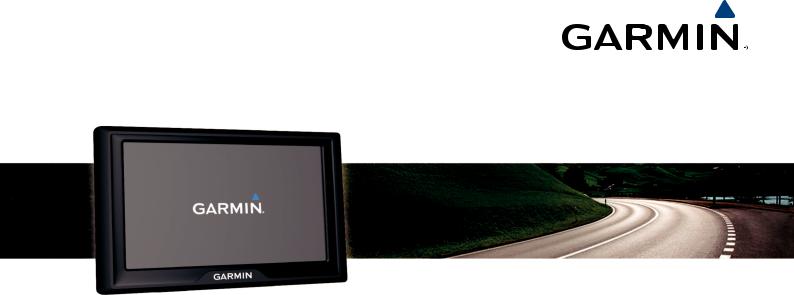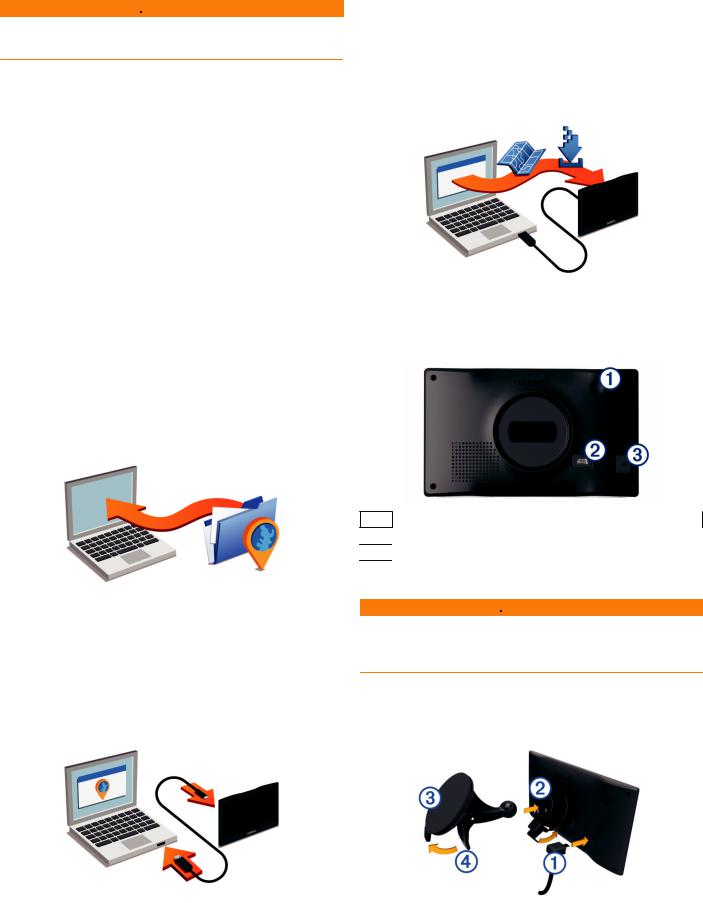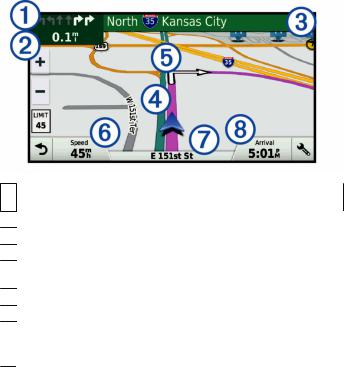Garmin Drive 5 Plus EU MT-S Summer, Drive 5 Europe User manual

Garmin Drive™ 5
Owner’s Manual
© 2017 Garmin Ltd. or its subsidiaries
All rights reserved. Under the copyright laws, this manual may not be copied, in whole or in part, without the written consent of Garmin. Garmin reserves the right to change or improve its products and to make changes in the content of this manual without obligation to notify any person or organization of such changes or improvements. Go to www.garmin.com for current updates and supplemental information concerning the use of this product.
Garmin® and the Garmin logo are trademarks of Garmin Ltd. or its subsidiaries, registered in the USA and other countries. These trademarks may not be used without the express permission of Garmin.
Garmin Drive™, Garmin Express™, myTrends™, nüMaps Guarantee™, and nüMaps Lifetime™ are trademarks of Garmin Ltd. or its subsidiaries. These trademarks may not be used without the express permission of Garmin.
Android™ is a trademark of Google Inc. Apple® and Mac® are trademarks of Apple Inc, registered in the U.S. and other countries. Foursquare® is a trademark of Foursquare Labs, Inc. in the U.S. and in other countries. microSD™ and the microSDHC logo are trademarks of SD-3C, LLC. Windows®, Windows Vista®, and Windows XP® are registered trademarks of Microsoft Corporation in the United States and other countries.

Getting Started
 WARNING
WARNING
See the Important Safety and Product Information guide in the product box for product warnings and other important information.
•Update the maps and software on your device (Updating Maps and Software with Garmin Express, page 1).
•Mount the device in your vehicle and connect it to power (Connecting the Device to Vehicle Power, page 1).
•Acquire GPS signals (Acquiring GPS Signals, page 2).
•Adjust the volume (Adjusting the Volume, page 2) and display brightness (Adjusting the Screen Brightness, page 2).
•Navigate to your destination (Starting a Route, page 3).
Support and Updates
Garmin Express™ (garmin.com/express) provides easy access to these services for Garmin® devices.
•Product registration
•Product manuals
•Software updates
•Map, chart, or course updates
Updating Maps and Software with Garmin Express
You can use Garmin Express software to download and install the latest map and software updates for your device. Map updates provide the latest available mapping data to ensure your device continues to calculate accurate and efficient routes to your destinations. Garmin Express is available for Windows® and Mac® computers.
1 On your computer, go to www.garmin.com/express.
7 Click Add Device.
8Follow the on-screen instructions to add your device to the Garmin Express software.
When setup is complete, the Garmin Express software searches for map and software updates for your device.
9Select an option:
•To install all available updates, click Install All.
•To install a single update, click View Details and select an update.
The Garmin Express software downloads and installs the updates onto your device. Map updates are very large, and this process may take a long time on slower Internet connections.
Garmin Drive 5 Device Overview
2Select an option:
•To install on a Windows computer, select Download for Windows.
•To install on a Mac computer, select Download for Mac.
3Open the downloaded file, and follow the on-screen instructions to complete the installation.
4 Start Garmin Express.
5Connect your Garmin device to your computer using a USB cable.
6Click Add a Device.
The Garmin Express software detects your device.
Power key
À
USB power and data port
Á
Map and data memory card slot
Â
Connecting the Device to Vehicle Power
 WARNING
WARNING
This product contains a lithium-ion battery. To prevent the possibility of personal injury or product damage caused by battery exposure to extreme heat, store the device out of direct sunlight.
Before you use your device on battery power, you should charge it.
1 Plug the vehicle power cable into the USB port on the
À
device.
2 Press the mount onto the suction cup until it snaps into
Á Â
place.
Getting Started |
1 |

3 Press the suction cup to the windshield, and flip the lever
Ã
back toward the windshield.
4Fit the tab on the top of the mount into the slot on the back of the device.
5 Press the bottom of the mount into the device until it clicks.
6Plug the other end of the vehicle power cable into a power outlet in your vehicle.
Turning the Device On or Off
•To turn the device on, press the power key, or connect the device to power.
•To put the device in power saving mode, press the power key while the device is on.
While in power saving mode, the screen is off and the device uses very little power, but it can wake instantly for use.
TIP: You can charge your device faster by putting it in power saving mode while charging the battery.
•To turn off the device completely, hold the power key until a prompt appears on the screen, and select Off.
The prompt appears after five seconds. If you release the power key before the prompt appears, the device enters power saving mode.
Acquiring GPS Signals
When you turn on your navigation device, the GPS receiver must collect satellite data and establish the current location. 



 in the status bar indicates the satellite signal strength. The time required to acquire satellite signals varies based on several factors, including how far you are from the location where you last used your navigation device, whether you have a clear view of the sky, and how long it has been since you last used your navigation device. The first time you turn on your navigation device, it may take several minutes to acquire satellite signals.
in the status bar indicates the satellite signal strength. The time required to acquire satellite signals varies based on several factors, including how far you are from the location where you last used your navigation device, whether you have a clear view of the sky, and how long it has been since you last used your navigation device. The first time you turn on your navigation device, it may take several minutes to acquire satellite signals.
1 Turn on the device.
2 Wait while the device locates satellites.
3If necessary, go outdoors to an open area, away from tall buildings and trees.
When 



 turns green, the device has acquired satellite signals and is ready for navigation.
turns green, the device has acquired satellite signals and is ready for navigation.
Status Bar Icons
The status bar is located at the top of the main menu. The status bar icons display information about features on the device. You can select some icons to change settings or view additional information.
GPS signal status. Hold to view GPS accuracy and acquired satellite information (Viewing GPS Signal Status, page 13).
Current time. Select to set the time (Setting the Time, page 11).
Battery charge level.
Using the On-Screen Buttons
On-screen buttons allow you to navigate the pages, menus, and menu options on your device.
•Select  to return to the previous menu screen.
to return to the previous menu screen.
•Hold  to quickly return to the main menu.
to quickly return to the main menu.
•Select  or
or  to scroll through lists or menus.
to scroll through lists or menus.
•Hold  or
or  to scroll faster.
to scroll faster.
•Select  to see a context-based menu of options for the current screen.
to see a context-based menu of options for the current screen.
Adjusting the Volume
1 Select Volume.
2Select an option:
•Use the slider bar to adjust the volume.
•Select  to mute the device.
to mute the device.
•Select  for additional options.
for additional options.
Adjusting the Screen Brightness
1 Select Settings > Display > Brightness.
2 Use the slider bar to adjust the brightness.
Driver Awareness Features and Alerts
NOTICE
The driver alerts and speed limit features are for information only and do not replace your responsibility to abide by all posted speed limit signs and to use safe driving judgment at all times. Garmin is not responsible for any traffic fines or citations you receive for failing to follow all applicable traffic laws and signs.
Your device provides features that can help encourage safer driving and increase efficiency, even when you are driving in a familiar area. The device plays an audible tone or message and displays information for each alert. You can enable or disable the audible tone or message for each type of alert. Not all alerts are available in all areas.
School zone or nearby school: The device plays a tone and displays the distance to and speed limit (if available) for an upcoming school or school zone.
Speed limit reduction: The device plays a tone and displays the upcoming reduced speed limit so you can be prepared to reduce your speed.
Speed limit exceeded: The device plays a tone and displays a red border on the speed limit icon when you exceed the posted speed limit for the current road.
Wrong way on a one-way street: The device plays a message and displays a full-screen warning if you travel the wrong way on a one-way street. The edges of the screen appear red and an alert remains at the top of the screen until you leave the one-way street or correct your direction of travel.
Railroad crossing: The device plays a tone and displays the distance to an upcoming railroad crossing.
Animal crossing: The device plays a tone and displays the distance to an upcoming animal crossing area.
Curve: The device plays a tone and displays the distance to a curve in the road.
Slower traffic: The device plays a tone and displays the distance to slower traffic when you approach slower traffic at a higher speed. Your device must be receiving traffic information to use this feature (Receiving Traffic Data Using a Traffic Receiver, page 9).
Fatigue warning: The device plays a tone and suggests upcoming rest stops after you have been driving for more than two hours without stopping.
Enabling or Disabling Audible Driver Alerts
You can turn off individual audible driver alerts. The visual alert appears even when the audible alert is disabled.
1 Select Settings > Map & Vehicle > Audible Driver Alerts.
2 Select or clear the check box next to each alert.
Red Light and Speed Cameras
NOTICE
Garmin is not responsible for the accuracy of or the consequences of using a red light or speed camera database.
2 |
Driver Awareness Features and Alerts |

NOTE: This feature is not available for all regions or product models.
Information about red light and speed camera locations is available in some areas for some product models. Go to garmin.com/speedcameras to check availability and compatibility, or to purchase a subscription or one-time update. You can purchase a new region or extend an existing subscription at any time.
You can go to mygarmin.com to update the camera database on your device. You should update your device frequently to receive the most up-to-date camera information.
For some devices and regions, basic red light or speed camera data may be included with your device. Included data does not include updates or a subscription.
Navigating to Your Destination
Routes
A route is a path from your current location to one or more destinations.
•The device calculates a recommended route to your destination based on the preferences you set, including the route calculation mode (Changing the Route Calculation Mode, page 4) and avoidances (Avoiding Delays, Tolls, and Areas, page 5).
•You can start navigating to your destination quickly using the recommended route, or you can select an alternate route (Starting a Route, page 3).
•If there are specific roads you need to use or avoid, you can customize the route (Shaping Your Route, page 4).
•You can add multiple destinations to a route (Adding a Location to Your Route, page 3).
Starting a Route
1Select Where To?, and search for a location (Finding and Saving Locations, page 6).
2 Select a location.
3Select an option:
•To start navigating using the recommended route, select
Go!.
•To choose an alternate route, select  , and select a route. Alternate routes appear to the right of the map.
, and select a route. Alternate routes appear to the right of the map.
•To edit the course of the route, select  > Edit Route, and add shaping points to the route (Shaping Your Route, page 4).
> Edit Route, and add shaping points to the route (Shaping Your Route, page 4).
The device calculates a route to the location and guides you using voice prompts and information on the map (Your Route on the Map, page 3). A preview of the major roads in your route appears at the edge of the map for several seconds.
If you need to stop at additional destinations, you can add the locations to your route (Adding a Location to Your Route, page 3).
Starting a Route by Using the Map
You can start route by selecting a location from the map. 1 Select View Map.
2 Drag and zoom the map to display the area to search.
3If necessary, select  to filter the displayed points of interest by category.
to filter the displayed points of interest by category.
Location markers ( or a blue dot) appear on the map.
or a blue dot) appear on the map.
4Select an option:
•Select a location marker.
•Select a point, such as a street, intersection, or address location.
5 Select Go!.
Going Home
The first time you start a route home, the device prompts you to enter your home location.
1 Select Where To? > Go Home.
2 If necessary, enter your home location.
Editing Your Home Location
1 Select Where To? >  > Set Home Location.
> Set Home Location.
2 Enter your home location.
Your Route on the Map
As you travel, the device guides you to your destination using voice prompts and information on the map. Instructions for your next turn or exit, or other actions appear across the top of the map.
Next action in the route. Indicates the next turn, exit, or other action
À
and the lane in which you should travel, if available.
Distance to the next action.
Á
Name of the street or exit associated with the next action.
Â
Route highlighted on the map.
Ã
Next action in the route. Arrows on the map indicate the location of
Ä
upcoming actions.
Vehicle speed.
Å
Name of the road on which you are traveling.
Æ
Estimated arrival time.
Ç
TIP: You can touch this field to change the information it shows (Changing the Map Data Field, page 9).
Viewing Turns and Directions
While navigating a route, you can view upcoming turns, lane changes, or other directions for your route.
1From the map, select an option:
•To view upcoming turns and directions as you navigate, select  > Turns.
> Turns.
The map tool displays the next four turns or directions beside the map. The list updates automatically as you navigate the route.
•To view the complete list of turns and directions for the entire route, select the text bar at the top of the map.
2Select a turn or direction (optional).
Detailed information appears. An image of the junction may appear for junctions on major roadways, if available.
Viewing the Entire Route on the Map
1 While navigating a route, select anywhere on the map. 2 Select 
 .
.
Adding a Location to Your Route
Before you can add a location to your route, you must be navigating a route (Starting a Route, page 3).
Navigating to Your Destination |
3 |
